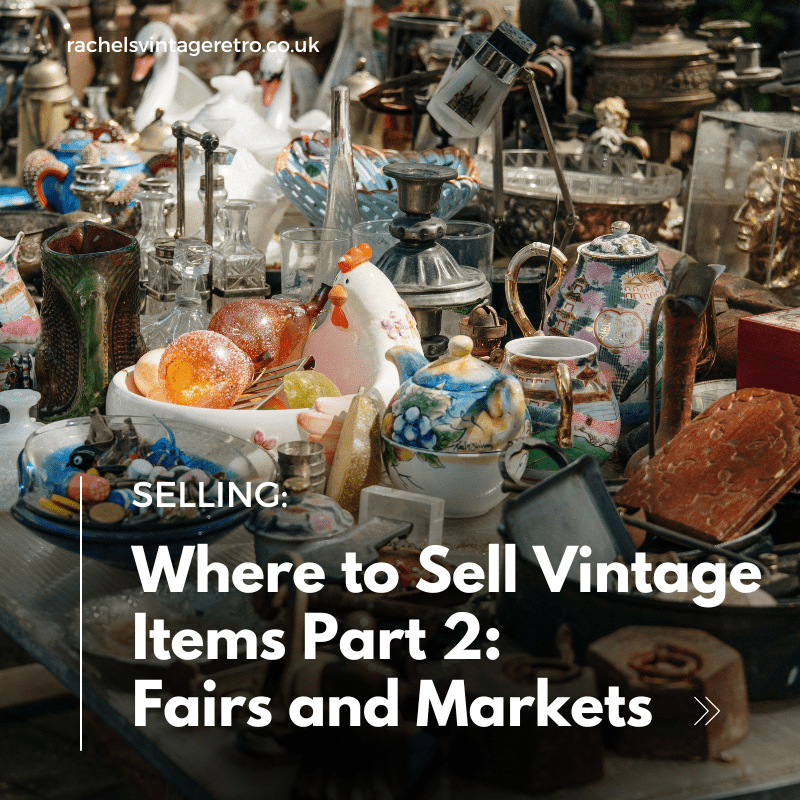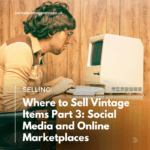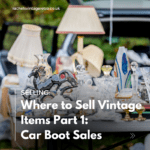As you progress in your vintage dealer journey, you will no doubt want to try selling your items in different places, and attract more customers. In the second of these series of articles, I talk further about where to sell vintage items, this time at Vintage Fairs and Markets. The previous article is here; Part 1, Selling at Car Boot Sales
These started out as flea markets and were often seen as the cheaper end of the fairs spectrum, traditionally places to sell second hand goods. However today they are often called Vintage Fairs or Markets to better reflect the type of goods sold. Vintage clothing, homewares, toys and other collectables all combine to provide a more unique and sustainable shopping experience.
Selling at Vintage Fairs and Markets
There are several types of vintage fairs and markets available to you as a vintage seller. One type is a growing trend for smaller vintage markets popping up along your high street or town’s marketplace. In my local area there is St Albans Vintage Market and Leighton Buzzard Vintage Market for example. These are usually in collaboration with the town’s council and consist of a group of vintage sellers, offering their wares from gazebos. They can be held all year round or just in the summer months. This is in contrast to other larger outdoor vintage fairs such as those run by ICAF, held at race courses etc, which often run over several days and are very well established.
There are also indoor events which will be called vintage fairs, collectors fairs, antiques fairs etc. These usually run throughout the year, with the Christmas fair often being a highlight. Some specialise in items for specific collectors, such as toy fairs, militaria, postcards, records etc. These type of fairs vary in size, and the smaller ones can be a bit disappointing. As a new dealer it is a good idea to attend a larger fair but not too large to be overwhelming (such as ICAF), otherwise both extremes are likely to put you off for good! It is a good idea to visit a few fairs first, to see which might be best for you and your business.
Booking a fair
Once you have decided on your fair, to book a stall you will need to contact the organiser. They will let you know if a stall is available, the cost, as well as anything else you need to know such as if tables are provided, access by car etc.
The stall fee is usually paid in advance and can be anything from £20 to £100 depending on the type of fair or market. Some fairs, especially smaller ones, tend to take the money on the day. You may also need public liability insurance, especially for outdoor events.
Preparing for a fair
This is fairly similar to the advice in my previous post, selling at Car Boot Sales. For example, make sure your goods are clean and undamaged, take a nice cloth to cover your tables, and pack up your goods carefully in bubble wrap and strong boxes. For a vintage fair you make need to take extra tables, spot lamps and display shelves if you need to. Remember that well presented stalls attract more buyers; you could even practice how you are going to organise things before the day.
For a vintage fair I would advise pricing items before the day. Unlike car boot sales, fair buyers prefer to see prices and make up their own mind whether to buy. This should be a bit higher than the final price you would like, to allow for haggling room. This does still happen at fairs. Also you will be ready for early buyers who are usually other dealers wanting to buy low. With a price on the item, you are less likely to panic and lose money. And remember you don’t have to lower your prices if you don’t want to!
On the day
Most fairs usually start at around 9 or 10 am, with the doors opening for set up around an hour or two earlier. It is a good idea to arrive early at the venue to give yourself a good parking space and room for unloading. If you arrive late you will probably have to park further away from the venue, with more distance to travel with your boxes when unloading, and this can be hard work. Take a flask of coffee or tea, plus some food with you as there may be some waiting around before you can get into the venue. Also as the fair will be running all day, you will need some other sustenance to keep you going, as there may not be food stalls included.
Remember to have a float with some change and your stall fee if it is due on the day. If you have a car machine, make sure it is charged up beforehand, and don’t forget to bring it! Being able to pay by card is what most people expect now and could make all the difference to your sales.
As with car boot sales, when selling, be approachable, helpful and friendly. Keep a positive attitude and if someone doesn’t want to buy that’s their choice. Prices are usually higher at a vintage fair and buyers may take longer to decide to buy. By all means start a conversation with buyers who look a bit unsure as this could help you close the sale, by offering them a bit more detail and reassurance.
As the day progresses at the fair you may find that sales are slower than a car boot sale. The fact that the fair is on all day gives buyers a choice of what time to arrive, although most people do attend mid morning – lunchtime. The afternoon can be quite slow but don’t lose heart, there may still be some buyers to come after lunch and in the last hour looking for bargains.
You will usually be expected to stay until the end of the fair, unless its very quiet. Then you may notice other stallholders packing up earlier. It is up to you if you want to follow suit, or want to stay till the end. Take your time to pack your remaining items well, and load them into your boxes, all safe and sound ready for the next fair!
This blog post is written by Rachel Toy, owner of Rachel’s Vintage & Retro. I am a 20th Century Vintage Blogger and Dealer writing about the vintage lifestyle, collecting, nostalgia and selling vintage. I also sell carefully curated 20th century antiques and collectables from my online vintage shop. I am happy to work with related brands on collaborations and also accept guest blogs. Find out how to work with me.




